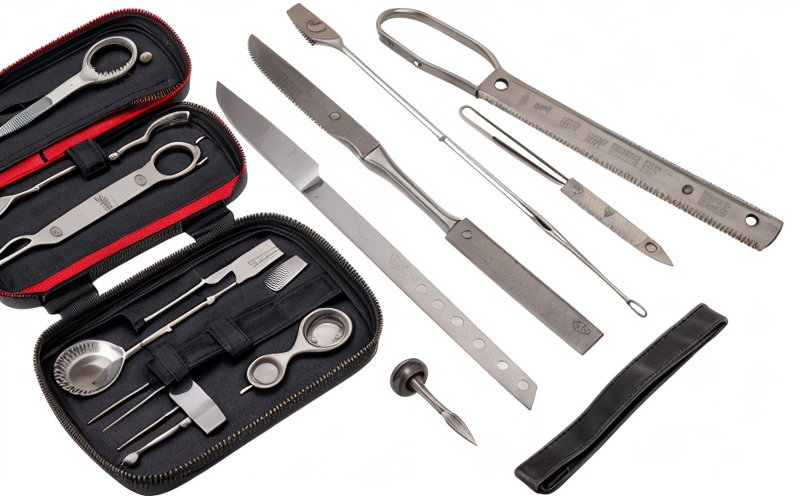Surface Roughness Testing of Surgical Tools
The quality and reliability of surgical tools are paramount in ensuring patient safety and successful outcomes. Surface roughness, a critical surface texture parameter, can significantly influence the performance, durability, and biocompatibility of surgical instruments. Accurate measurement and control of surface roughness are essential for compliance with international standards such as ISO 4287:1997 (Geometrical Product Specifications - Surface Texture) and ISO 1302:2012 (Surface texture: Profile method -- Terms, definitions and surface texture parameters).
Surgical tools used in various procedures must meet stringent requirements regarding their surface finish. For instance, instruments that contact blood or tissues directly require a smooth surface to minimize the risk of infection and irritation. This section will delve into the process, equipment, standards, and applications involved in conducting precise surface roughness testing on surgical tools.
The testing procedure typically involves preparing the surgical instrument according to specific guidelines provided by the manufacturer or regulatory bodies. After preparation, the tool is placed under a profilometer, which measures the height variations of the surface over a defined length and width. The result provides various parameters like Ra (Arithmetic Average Roughness), Rz (Maximum Height of Irregularities), and Rq ( RMS Roughness).
For quality managers and compliance officers responsible for ensuring that surgical tools meet rigorous standards, surface roughness testing is crucial. This parameter can affect the tool's ability to hold a sharp edge or resist corrosion. Inadequate surface roughness could lead to premature wear, increased friction during use, and potential damage to delicate tissues.
R&D engineers benefit from this service by being able to refine designs and materials for better performance. By optimizing surface roughness, they can enhance the tool's functionality while maintaining safety standards. Procurement teams also find value in this testing as it helps them select suppliers who adhere strictly to quality control processes.
Quality and Reliability Assurance
In the realm of medical device manufacturing, ensuring consistent product quality across all stages of production is paramount. Surface roughness testing plays a crucial role in this process by providing objective data that can be used to monitor changes over time or between batches. This section will explore how surface roughness testing contributes to maintaining high standards of quality and reliability.
- Identifying deviations from standard specifications
- Detecting early signs of wear or degradation
- Verifying compliance with regulatory requirements
- Supporting continuous improvement initiatives
The proficiency of surface roughness testing extends beyond mere measurement; it encompasses the ability to interpret results accurately and translate them into actionable insights. By leveraging advanced analytical techniques, laboratories can pinpoint specific areas for improvement, thereby enhancing overall product quality.
Quality assurance teams play a vital role in ensuring that each surgical tool meets predetermined criteria before being released onto the market. They rely heavily on reliable surface roughness testing to maintain stringent standards and guarantee patient safety. Through regular audits and inspections, they can identify any discrepancies between actual measurements and desired values, prompting corrective actions if necessary.
Customer Impact and Satisfaction
Surgical tools with optimal surface roughness enhance patient safety by reducing the risk of infection or irritation. This translates directly into improved patient outcomes, leading to higher customer satisfaction.
Achieving compliance with international standards ensures that products are accepted globally, broadening market reach and fostering stronger customer relationships.
For quality managers, the ability to consistently meet high-quality benchmarks translates into enhanced reputation and trust within the industry. Compliance officers can rest assured knowing they are adhering to strict regulations, which helps maintain regulatory approval. R&D engineers gain valuable feedback from reliable testing, allowing them to innovate continuously.
Use Cases and Application Examples
| Use Case | Example Surgical Tool | Surface Roughness Parameter | Purpose of Testing |
|---|---|---|---|
| Ensuring blade sharpness for precision cuts. | Cutting blades used in laparoscopic surgery. | Ra, Rz values below specified limits. | To prevent tissue damage and ensure accurate incisions. |
| Evaluating handle ergonomics for reduced user fatigue. | Handle grips designed for ergonomic comfort. | Rq value within recommended range. | To improve grip stability during prolonged procedures. |
| Verifying material integrity against corrosion risks. | Stainless steel retractors used in orthopedic surgeries. | Ra, Rz values above minimum thresholds. | To ensure longevity and reliability under harsh conditions. |
| Detecting wear patterns for predictive maintenance. | Screwdrivers employed during spinal fusion procedures. | Changes in Ra over time compared to baseline data. | To anticipate when replacement or repair is necessary. |
In each of these scenarios, accurate surface roughness testing provides critical information that supports better decision-making. It allows manufacturers to fine-tune their processes, ensuring that every surgical tool meets the highest standards.
Identifying areas prone to wear and tear through regular monitoring.
Adjusting manufacturing parameters based on real-world performance data.





